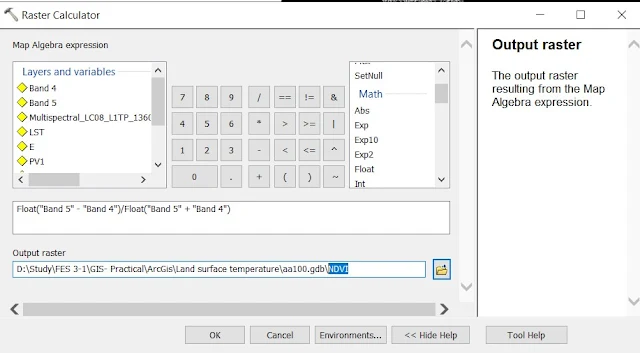Land Surface Temperature (LST) is the temperature of the earth's surface which is the radiative skin temperature of the land derived from infrared radiation. In the SLSTR project, the "skin" temperature is the top surface temperature in the bare soil condition. It is also effective in emitting vegetation canopy temperature.
This tutorial is about to show you how to calculate Land Surface Temperature in 6 steps.
So, the first step is to Download the Landsat 8 bands of your study area. After you have finished downloading just unzip that file and you will have all your information there. As in the Landsat 8, you will have 11 bands. For calculating the LST we are going to need 3 bands. One of them is Band 10, which is the thermal band. And for calculating NDVI we will use Band 4 and Band 5 which are Red and Near Infra-red bands.
For calculating the LST we have to calculate some algorithm in the raster calculator.
STEP 1: Calculation of Top Of Atmosphere (TOA) radiance
Conversion to Top Of Atmosphere (TOA) Radiance. Using the radiance rescaling factor, Thermal Infra-Red Digital Numbers can be converted to TOA spectral Radiance.
TOA (L) = ML * Qcal + AL - Oi
Where,
ML = Radiance multiplicative Band no. 10
Qcal = Quantized and calibrated standard product pixel values (DN), Band 10
Oi = Correction value for Band 10 is -2.1k (you can find that in google)
AL = Radiance add band no. 10
Open ArcMap software and add band 10 of the Landsat 8 image you have just downloaded. Then go to the search bar by pressing Ctrl+F. And search for the raster calculator.
Now, in the raster calculator toolbox write this algorithm,
STEP 2: Conversion to Top Of Atmosphere (TOA) Brightness Temperature (BT)
Spectral radiance data can be converted to Top Of Atmosphere Brightness Temperature (BT) using the thermal constant values in the metadata file.
Kelvin to Celsius Degrees (°C)
BT = k2 / ln(k1/TOA+1)-273.15
Where,
BT = Top Of Atmosphere Brightness Temperature (°C)
TOA = Top Of Atmosphere Spectral Radiance
k1 = k1 constant band no.
k2 = k2 constant Band no.
STEP 5: Land Surface Emissivity
LSE is the average emissivity of an element of the surface of the earth calculated from NDVI values.
ε = 0.004 * Pv + 0.986
Where,
ε = Land surface Emissivity
Pv = Proportion of vegetation
STEP 6: Calculate the Land Surface Temperature
LST = BT / (1 + λ * BT / c2 * ln (ε))
Where,
LST = Land Surface Temperature
BT = Brightness Temperature
λ = Wave length of emitted radiance
e = Land Surface Emissivity
C2 = h * c / s = 1.4388 * 10-2 mk = 14388 µmk
H = Plank’s constant = 6.626 * 10-34
js
S = Boltzman constant = 1.38 * 10-13
Jk
C = Velocity of light = 2.998 * 108
m/s
As a result of the process develop we can see the map of Land Surface Temperature ( LST). It is important to notice that it is not equal to the air temperature.
This is our final map. The Picture taken time of the Landsat 8 was January which is the winter season in Bangladesh. So, we can see on the map is that the higher temperature at that particular time was 24°C and the lowest temperature was 7°C. So, comment below How do you find your results.Thank you.


















2 Comments
Hii, i am having problem with the Temperature range in land sat 8 y 9 the range is to high 82 and low 39 °c how can i fix it ?
ReplyDeletesame problem
Delete